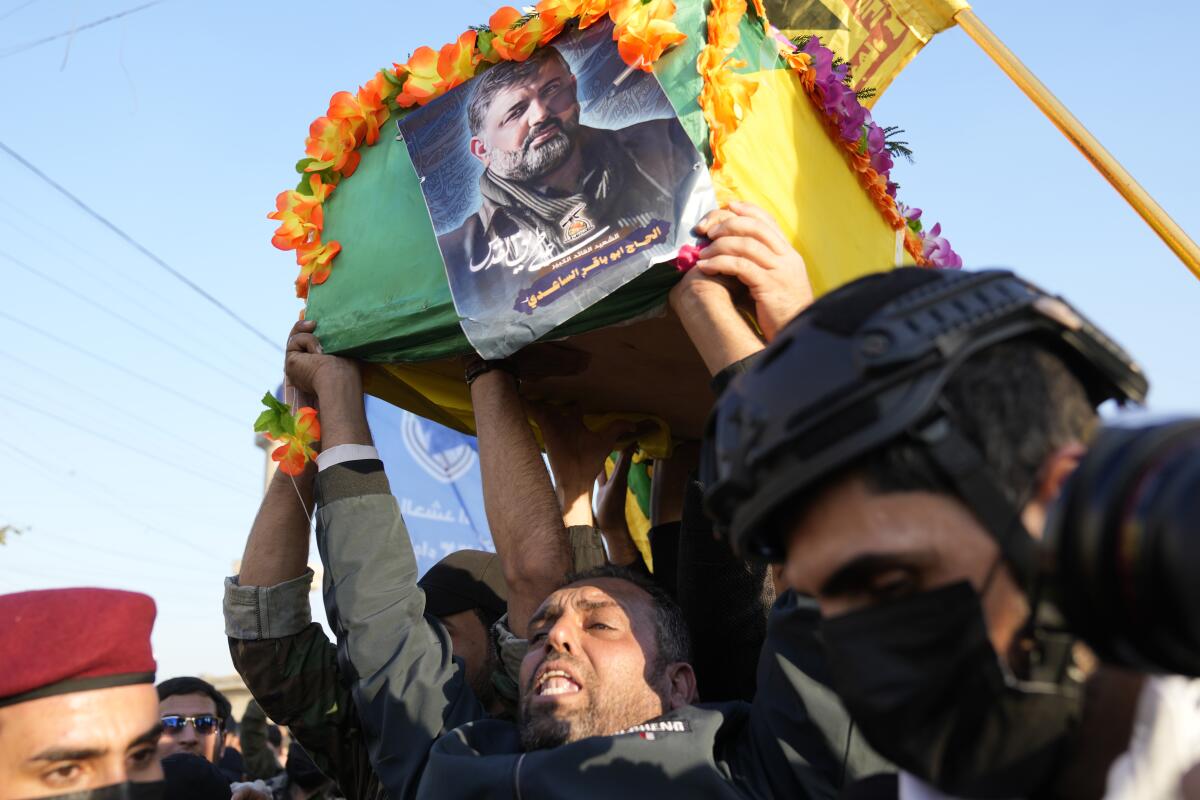A look at the Iraqi government’s relationship with armed groups clashing with U.S. forces

- Share via
BEIRUT — A U.S. strike in Baghdad that killed a commander of the powerful Kataib Hezbollah paramilitary group last week highlighted the ambiguous status of the country’s Iran-allied armed factions. Some operate simultaneously as a part of the official security forces and outside of state control.
That has put the government of Prime Minister Mohammed Shia al-Sudani in an increasingly delicate position as it attempts to balance between its relations with the United States and with Iraqi armed groups that are sometimes in direct conflict with U.S. forces.
Here’s a look at the complicated relationship between Iraq, paramilitary groups such as Kataib Hezbollah and the United States:
What is Kataib Hezbollah?
Kataib Hezbollah is one of the most powerful armed groups in Iraq. It was formed during the power vacuum that followed the 2003 U.S.-led invasion of Iraq, with support from Iran’s Islamic Revolutionary Guard.
The Iraqi faction is part of the Popular Mobilization Forces. The PMF is a coalition of primarily Shiite, Iran-backed armed groups that joined in the fight against the Islamic State group after it seized large sections of Iraq in 2014.
The PMF became allies of convenience with forces from a U.S.-led international coalition fighting Islamic State.
However, Kataib Hezbollah and some other groups that are part of the PMF also have attacked U.S. forces in Iraq.
The U.S. has designated Kataib Hezbollah as a terrorist group. In January 2020, a U.S. airstrike killed the group’s founder, Abu Mahdi al-Muhandis, and Iranian Gen. Qassem Suleimani.
Wednesday’s strike killed Wissam Muhammad Sabir al-Saadi, known as Abu Baqir al-Saadi, who was in charge of Kataib Hezbollah’s operations in Syria. The U.S. has said he was responsible for “directly planning and participating in attacks” on American troops.
What is the relationship between the paramilitary groups and the Iraqi state?
In 2016, the Iraqi government designated the Popular Mobilization Forces as an “independent military formation” within the Iraqi armed forces.
However, some of the groups that make up the PMF are also part of the Islamic Resistance in Iraq, which has launched around 170 strikes against bases housing U.S. troops in Iraq and Syria over the past four months. The group has said it is retaliating for Washington’s support of Israel in the ongoing war in Gaza and aims to push U.S. troops out of the region.
The Iraqi government has condemned the strikes on U.S. forces while also in many cases condemning the U.S. response, particularly when it has conducted strikes in the capital or hit PMF factions that did not have a clear role in the attacks on U.S. forces.
Renad Mansour, a senior research fellow at the Chatham House, said the PMF is effectively an arm of the Iraqi government. “They view themselves as protecting the state,” whether by fighting against Islamic State or by cracking down on anti-government protesters, he said.
Lahib Higel, a senior analyst for Iraq at the International Crisis Group, said some of the armed groups in the PMF have a dual role.
“They have a day job, which is their work in the [PMF]. And they have another role, which is that they conduct these resistance operations against the U.S. presence,” she said.
What has been the reaction in Iraq to the U.S. strike?
Maj. Gen. Tahsin al-Khafaji, spokesman for the Joint Operations Command, which includes an array of Iraqi security forces, accused the U.S. on Thursday of “clear aggression and a violation of Iraqi sovereignty.”
Iraqi military spokesman Yehia Rasool called Wednesday’s strike a “blatant assassination ... in the heart of a residential neighborhood in the capital.”
The Coordination Framework, a coalition of mainly Shiite, Iran-allied political parties that brought Sudani to power in late 2022, urged the prime minister to intensify efforts to end the presence of the U.S.-led military coalition in the country.
Last month, Iraqi and U.S. military officials launched formal talks to wind down the coalition’s mission, but the process was paused a day later after a drone attack by the Islamic Resistance in Iraq against a base in Jordan killed three U.S. troops.
What will happen next?
While tensions are rising, Mansour said, “no side actually wants an all-out confrontation, a direct war, in Iraq.”
Instead, he said, the U.S. and Iraq will likely continue to work toward an exit by the coalition forces and move toward establishing bilateral relations between the two countries.
Higel said the Iran-allied factions will likely now push the Iraqi government for an accelerated timeline for phasing out the coalition.
“The U.S. won’t leave under threat and with a gun to their head, so to speak, so it’s a bit of a catch-22,” she said. “You need de-escalation in order to hold those talks and actually reach some results.”
More to Read
Sign up for Essential California
The most important California stories and recommendations in your inbox every morning.
You may occasionally receive promotional content from the Los Angeles Times.










